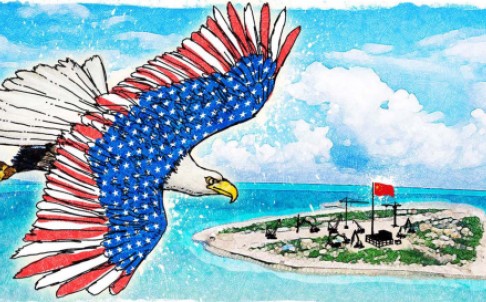
On 21 November, US President Barack Obama said at an ASEAN (Association of Southeast Asian Nations) conference that countries in the region should cease the ‘reclamation, construction and militarisation of disputed areas’ in the South China Sea for the sake of ‘regional stability’. The dispute, which relates to the ownership of several island archipelagos in the area, has its roots in the aftermath of the Second World War but has intensified in recent years as a result oil exploration in the area and the crucial shipping lanes that run through the sea. Obama’s words were primarily directed at China’s building of military and civilian facilities in the Spratly Archipelago, a development which was challenged only the week before his speech by the over-flight of two armed B-52 bomber planes. China has laid claim to a large portion of the area as far south as the Malaysian coast, denoted by the ‘nine-dash line’ and based on its historical claims to many of the islands. However, these claims overlap with those made by other countries in the region, including Malaysia, the Philippines, Indonesia, Vietnam and Brunei.
This must be seen in a wider context as part of an ongoing attempt by US imperialism to encircle China, which it sees as a threat both economically and militarily. The US has not chosen to engage in the same sabre-rattling towards Indonesia’s moves to militarise the Natuna archipelago, which includes the deployment of warships and fighter jets. Similarly the US has grown closer to China’s southern neighbour, Vietnam, which only a couple of decades ago was subject to an extensive US economic embargo, rivalling the one that still exists against Cuba. Now it is a member-state of the new Trans-Pacific Partnership (TPP), a ‘free trade’ agreement the US Secretary of Defence Ashton Carter described as ‘as important to me as another aircraft carrier’. This agreement represents a huge step forward in achieving the US ‘pivot to Asia’ strategy, in which it is re-orienting its military towards a future conflict with China. It also represents a victory for US investors in further opening up the land, labour and markets of Asia to imperialist exploitation.
Meanwhile in Japan, another US ally, there is continuing controversy over the attempted repeal of Article 9 of the Japanese post-war constitution which severely restricts the size and scope of the military, but in reality Japan has already gone much of the way down the road to remilitarisation. Article 9 has now been reinterpreted in such a way that it now allows Japan to act in ‘collective self-defence’ if one of its allies is attacked. The Japanese government’s dispute with China over the Diaoyu islands has been used as an excuse for the expansion of the Japanese army. Combined with this have been increasingly provocative rhetoric and actions from the Abe government, including visits by Abe himself to the Yasukini Shrine that commemorates soldiers killed in Japanese imperialism’s wars – a commemoration which includes over 1,000 convicted war criminals from the Second World War. Japan has additionally continued to deny the sexual enslavement of thousands of Chinese and Korean ‘comfort women’, and many public officials have also denied the Nanjing massacre of 1937, which killed up to 300,000 Chinese civilians during the Sino-Japanese war. All of these have inflamed relations between China and Japan.
Although China has opened its economy up to investment from the West to an increasing degree in the last 40 years, many of the largest industries remain controlled by the Chinese state and the government retains tight control over foreign investment. This, combined with China’s increasing investment in Africa and the growth of its economic power (including the recent addition of the yuan to the IMF’s reserve currency basket and the creation of the Asian Infrastructure Investment Bank, which has been joined even by close US allies like Britain and Australia) have made China an obstacle to US ambitions at achieving world hegemony and explain why US imperialism and its allies are so determined to contain and control China. The redeployment of US military power to East Asia, the growth of Japanese nationalism and militarism, and the increased tensions between the US-allied government in South Korea and China’s ally in the North are all steps towards isolating China, and they go hand in hand with similar efforts to contain Russia in Europe and the Middle East.
The escalation of the South China Sea territorial disputes represents the latest front in the conflict between imperialism and any nation that attempts to protect its economic independence..




